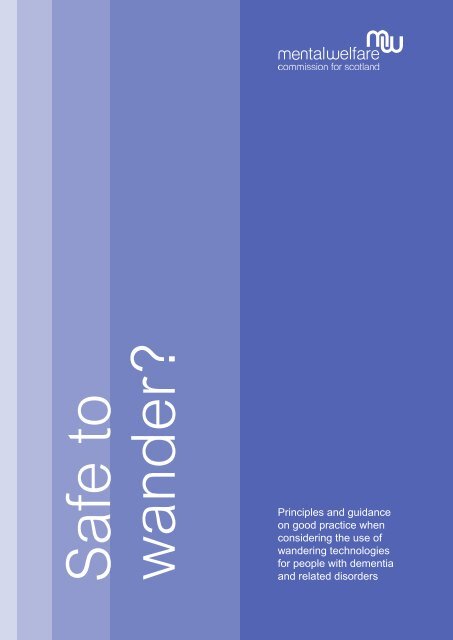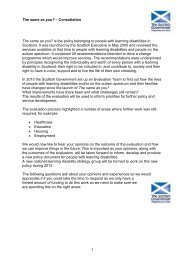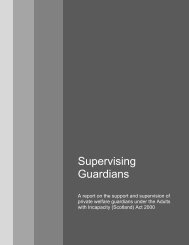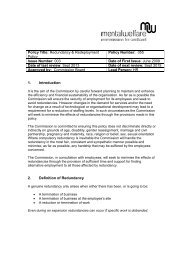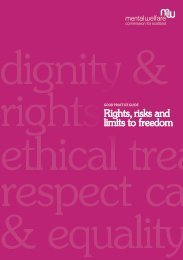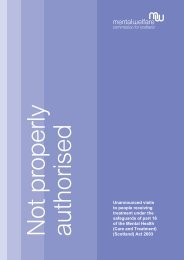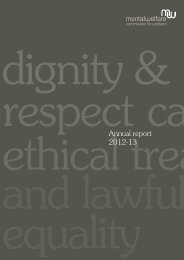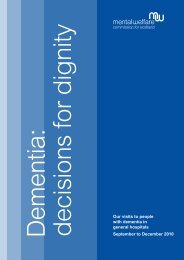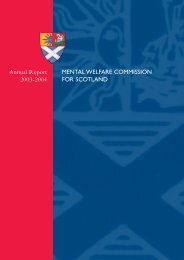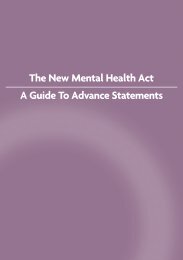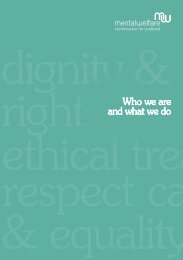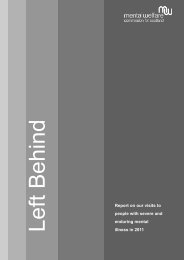Safe to wander - Mental Welfare Commission for Scotland
Safe to wander - Mental Welfare Commission for Scotland
Safe to wander - Mental Welfare Commission for Scotland
- No tags were found...
You also want an ePaper? Increase the reach of your titles
YUMPU automatically turns print PDFs into web optimized ePapers that Google loves.
<strong>Safe</strong> <strong>to</strong><strong>wander</strong>?Principles and guidanceon good practice whenconsidering the use of<strong>wander</strong>ing technologies<strong>for</strong> people with dementiaand related disorders
ContentsWhy have we prepared this guidance? 1What do we mean by ‘<strong>wander</strong>ingtechnology’ and why is it an issue? 2General principles in consideringthe use of new technologies 4Considering the use of <strong>wander</strong>ingtechnology: assessment and care planning 5Physical assessment 5Psychological assessment 6Assessment of risk 7Alternatives <strong>to</strong> <strong>wander</strong>ing technology 7The care plan 8Consulting with the Care <strong>Commission</strong> 8Important legal considerations 9Summary and good practice checklist 10Checklist 11Bibliography 12Acknowledgements 12
1Why have we preparedthis guidance?The <strong>Commission</strong> has anactive role in ensuring thatindividuals have access<strong>to</strong> care which is mostappropriate <strong>to</strong> theirindividuality, their uniquecare needs and their humanrights. We are often askedabout restraint and restrictionsplaced on individuals inmental health, learningdisability and older people’sservices. In response <strong>to</strong> thesewe produced ‘Rights, risksand limits <strong>to</strong> freedom’ whichsets out our views on the lawand good practice in thisarea of practice. In addition<strong>to</strong> questions on the broaderissues, the <strong>Mental</strong> <strong>Welfare</strong><strong>Commission</strong> is occasionallyasked <strong>for</strong> advice on the useof technology in caring <strong>for</strong>people with dementia,learning disabilities andrelated disorders. Ourresponse is generally thatwe believe that technologycan be a valuable <strong>to</strong>olwhich has the potential <strong>to</strong>help people <strong>to</strong> maintain theirindependence and enhancetheir freedom and that,where new technologycan provide assistancewithout unduly restrictingor increasing the risks thatan individual may face,its use is <strong>to</strong> be welcomed.This publication providesmore specific guidance<strong>for</strong> those considering theuse of new technologies,particularly in support ofindividuals with dementiawho are resident incare homes or hospitals.Although we focus ondementia and residentialcare, the principles of thisguidance may also provehelpful <strong>for</strong> people working <strong>to</strong>provide care and treatment<strong>for</strong> other mental disordersin a range of settings,especially as the use ofemerging technologiesevolves <strong>to</strong> provide homebased alternativesresidential care.The <strong>Commission</strong> are notthe only source of advicein this area, guidance <strong>for</strong>staff working in <strong>Scotland</strong>has also been prepared byNational Care StandardsCommittee and staff willalso be supported bypolicy and proceduresguidance prepared withintheir own services.
2Those consideringthe use of <strong>wander</strong>ingtechnologies have <strong>to</strong> beaware of the potential <strong>for</strong>this <strong>to</strong> constitute restraint.What do we mean by‘<strong>wander</strong>ing technology’and why is it an issue?The term ‘<strong>wander</strong>ing’ canhave negative connotations.For the individual concernedhowever ‘<strong>wander</strong>ing’ isusually a positive experiencewhich can provide physicaland psychological benefits.The <strong>Commission</strong> recognisesthat this term is oftenmistakenly used <strong>to</strong> describea wide number of differingtypes of behaviour and canbe considered unhelpful,particularly in relation <strong>to</strong>people with a learningdisability. After a long debatehowever, we have decided <strong>to</strong>refer <strong>to</strong> ‘<strong>wander</strong>ing’ in thisdocument as it remains,rightly or wrongly, the termmost commonly used indementia care settings.‘Wandering’ sometimessuggests aimless walking.This is sometimes the case,but it is more likely that thebehaviour has meaning <strong>for</strong>the person with dementia.It is important <strong>to</strong> try <strong>to</strong>understand where theperson is trying <strong>to</strong> go and<strong>to</strong> recognise that walking <strong>to</strong>destinations of interest willbe of benefit <strong>to</strong> the person.We need <strong>to</strong> recognise that‘<strong>wander</strong>ing’ is not necessarilybad and that the personshould be able <strong>to</strong> walk freelyand safely.In ‘Rights, risks and limits<strong>to</strong> freedom’ the <strong>Commission</strong>set out its definition ofrestraint. ‘restraint is takingplace when the planned orunplanned, conscious orunconscious actions of carestaff prevent a resident orpatient from doing what heor she wishes <strong>to</strong> do and asa result is placing limits onhis or her freedom.’ Basedon this definition, thoseconsidering the use of<strong>wander</strong>ing technologiesclearly have <strong>to</strong> be aware ofthe potential <strong>for</strong> their practice<strong>to</strong> constitute restraint and <strong>to</strong>take this in<strong>to</strong> account in theirdecision making.There are many examples ofthe creative use of technology<strong>to</strong> support safe movementin care homes and hospitalsand technology is increasinglybeing used in individuals’own homes. Wanderingtechnology that can be putin place could include:• Sensor pads(beds, chair, floor)• Nurse/carer call systems• Panic but<strong>to</strong>ns• Fall and movement sensors• Electronic tagging andtracking systems• CCTV/video surveillance• Intruder alertsThis document will focusexclusively on the use of‘tagging’ and trackingdevices. The term taggingis often associated withcriminal activity andsurveillance, shoppingand the prevention of crime.It can involve the use ofsatellite technology <strong>to</strong> alertthe police or probationservices that a person is inbreach of parole conditionsor a curfew. The use ofelectronic tagging in thisdocument is only in relation<strong>to</strong> care settings and hasno criminal component.To avoid confusion, the term‘<strong>wander</strong>ing technologies’ willbe used in this document,nevertheless thoseconsidering its use shouldstill be sensitive <strong>to</strong> theperceptions that serviceusers, carers and staff mayhave of the technology.The use of <strong>wander</strong>ingtechnology is primarilyused <strong>for</strong> individuals who areconsidered <strong>to</strong> be at risk fromleaving a care environmentunescorted. It mainlyinvolves the use of boundary
3crossing alarms wherebya member of the care staffis alerted when an individualcrosses a pre-designatedboundary. The alarm alertscare staff that an individualresident is possibly at riskof leaving, though the systemitself does not prevent themfrom doing so. Wanderingtechnology also includesthe use of tracking deviceswhich can locate the wearerif he/she becomes lost orfails <strong>to</strong> return. Trackingdevices are currently rarelyused in this country <strong>for</strong>individuals in care homesettings but the technologyis now becoming increasinglyeasily available and financiallyaf<strong>for</strong>dable. Tracking devices,using global positioningsystem satellite technology,are currently being usedin Spain <strong>for</strong> some patientswith Alzheimer’s disease.Small electronic devices areattached <strong>to</strong> the individual’sclothing and they emit asignal which can be tracedif the individual strays froma previously designated area.New technology may providea less restrictive or morebeneficial care option thanother ways of managingan individual who <strong>wander</strong>s.A survey in 1998 suggestedthat up <strong>to</strong> 40% of individualswith dementia become lostat some point during theirillness and 5% get lostrepeatedly over manymonths. Over 70% of thosewho get repeatedly lost areadmitted in<strong>to</strong> institutionalcare as a means <strong>to</strong> managethe risks of their illness.Many care establishmentsare locked or have barrierssuch as keypads or handlearrangements that requiresome skill <strong>to</strong> open. Suchbarriers can then restrictthe free movemen<strong>to</strong>f all residents of theestablishment, regardlessof whether they are at riskfrom <strong>wander</strong>ing.For those individualsalready in residential care,<strong>wander</strong>ing behaviour mayincrease, or pose a particularrisk <strong>to</strong> an individual, whomay as a result be moved <strong>to</strong>a more secure environment.This can prove unsettling<strong>for</strong> the resident and <strong>for</strong>carers. Where the use oftechnology can play a partin maintaining independence,or enabling continuity ofcare, we think it should beconsidered.It is also worth recognisingthat physical activity maintainsand improves general healthand reduces the risk offalling in the elderly. Peoplewith dementia who have thefreedom <strong>to</strong> <strong>wander</strong> receivepositive health benefits fromtheir activity and <strong>wander</strong>ingtechnologies could havea part <strong>to</strong> play in promotingindividual health andwellbeing.
4On no account shouldtechnology be usedmerely <strong>to</strong> save on thecost of appropriatestaffing.General principlesin considering the useof new technologiesThe key <strong>to</strong> best managemen<strong>to</strong>f <strong>wander</strong>ing behaviour is <strong>to</strong>allow the person <strong>to</strong> walk freelyand <strong>to</strong> destinations of interestwithout subjecting the person<strong>to</strong> unnecessary or causingunnecessary distress. Theuse of technology maycontribute <strong>to</strong> this, but only inconjunction with good designof the living environment,stimulation, meaningfulactivity and appropriatelytrained care-givers.A person <strong>for</strong> whom the useof <strong>wander</strong>ing technologyis being considered is likely<strong>to</strong> lack capacity in relation<strong>to</strong> decisions about its use,although this should not beassumed. Where capacityis lacking, it is important thatthe principles of the Adultswith Incapacity (<strong>Scotland</strong>)Act 2000 are applied indecision making:The intervention mustprovide a benefit that canno<strong>to</strong>therwise be achievedWhat will the benefit ofthe technology be <strong>to</strong> theindividual? If usedappropriately the benefitmay be improved personalsafety, increased dignity,independence and senseof freedom. It may reducethe need <strong>for</strong> obtrusive levelsof observation that could bedistressing <strong>for</strong> the individual.There might be drawbacks <strong>to</strong>the use of such technology.Apart from unnecessaryrestriction of freedom,(see below) it may providea false sense of security.The person may travel withinan apparently safe area butmay not be alert <strong>to</strong> significantrisks within that area. Also,the person may leave thesafe area and suffer harmbe<strong>for</strong>e care-givers canrespond <strong>to</strong> an alert. Theuse of new technology mayreduce personal contactwith care-givers and this isunlikely <strong>to</strong> benefit the person.Technology is no substitute<strong>for</strong> appropriate levels ofpersonal care and humaninteraction. On no accountshould technology be usedmerely <strong>to</strong> save on the cos<strong>to</strong>f appropriate staffing.The intervention must be theleast restrictive in relation <strong>to</strong>the person’s freedom in order<strong>to</strong> achieve the desired benefitWill the technology resultin the least restrictionconsistent with the person’sdignity, safety andindependence? There islikely <strong>to</strong> be a tensionbetween protection andsafety, versus privacy anddignity. Technology mayallow the person morefreedom than locking doorsor having a member of staffwatch the person at all times.However if the person oftenhas <strong>to</strong> be retrieved andreturned <strong>to</strong> the place ofresidence, it may resultin increased distress orpublic ridicule.The past and present wishesof the person must be takenin<strong>to</strong> accountCare-givers should notassume that the personlacks capacity in relation<strong>to</strong> <strong>wander</strong>ing technology.People whose cognitive abilityfluctuates may be capable ofstating their wishes <strong>to</strong> be safeduring periods of increasedconfusion and can participatefully in decisions. Even whenthe person appears <strong>to</strong> lackcapacity, care-givers mustmake every ef<strong>for</strong>t possible
5<strong>to</strong> discuss such risks and <strong>to</strong>help the person <strong>to</strong> understandthe benefits of technologysolutions. Care-givers shouldmake a careful record ofsuch discussions includingwhether the person agreesor disagrees with the useof technology. This must beapproached with sensitivityand only after the person hashad time <strong>to</strong> come <strong>to</strong> termswith his or her diagnosisand its implications.The views of relevant othersshould be taken in<strong>to</strong> accountA wide range of people willhave valuable roles <strong>to</strong> playin the decision on whether<strong>to</strong> use <strong>wander</strong>ing technology,including:• Nearest and close relativesand friends will knowthe person best andcan provide valuablein<strong>for</strong>mation about his/herlife. This may be crucial inunderstanding the person’sbehaviour. They will alsohave views about risks anddignity and these shouldbe taken in<strong>to</strong> account.• A welfare at<strong>to</strong>rney orguardian with powersover the person’s welfaremay have the authority<strong>to</strong> consent <strong>to</strong> the useof <strong>wander</strong>ing technology.Even where a specificpower is not included inthese granted these mayinclude decisions onthe person’s place ofresidence, which may beaffected by the potentialuse of technology. In suchcases it is important <strong>to</strong>consult such a person onthe use of technology.• Professional carers willhave experience inmanaging <strong>wander</strong>ingbehaviour, in particular theiradvice on environmentaldesign or modificationsand assessment of riskwill aid the decisionmaking process.The intervention shouldencourage the person <strong>to</strong> useexisting skills and developnew onesThis principle is <strong>to</strong> beobserved by at<strong>to</strong>rneys,guardians and managersof care establishments,and represents good practice<strong>for</strong> anyone involved in theperson’s care. If the useof technology <strong>to</strong> manage<strong>wander</strong>ing behaviourincreases the opportunity<strong>for</strong> the person <strong>to</strong> use existingskills and <strong>to</strong> develop newones, then it merits seriousconsideration.Considering the use of<strong>wander</strong>ing technology:assessment and careplanningPrior <strong>to</strong> introducing any<strong>wander</strong>ing technologysystem there should becareful physical andpsychological assessment<strong>to</strong> eliminate any reversiblecause of the <strong>wander</strong>ingbehaviour. This assessmentwould involve analysing whatis actually happening, whenit is happening, what triggersthe behaviour and whatintervention helps.• Physical assessmentAny physical assessmentsshould be multi-disciplinaryand should include:Medication reviewMany medications <strong>for</strong> bothphysical and psychiatricconditions have side-effectswhich can include mo<strong>to</strong>rrestlessness, confusion andconstipation amongst others.All of these side-effectscan contribute <strong>to</strong> thedevelopment of worsening<strong>wander</strong>ing behaviour andmedications should beregularly reviewed by themedical practitioner(particularly those supplied<strong>for</strong> the treatment of anxiety,depression and insomnia).
6EliminationConstipation or urinarydiscom<strong>for</strong>t can lead <strong>to</strong>restlessness and shouldbe addressed. Searching <strong>for</strong>a <strong>to</strong>ilet and worries aboutincontinence can also bean issue. Toilets should beclearly identified.Pain assessmentSome people with dementiaare not able <strong>to</strong> express theirpain, which can manifest asrestlessness or increasedconfusion. The physicalexercise that <strong>wander</strong>ingprovides may prevent paindeveloping, or provide a <strong>for</strong>mof pain relief in itself. Earlypressure sore developmentcan cause extreme pain withno obvious visible injury.Other fac<strong>to</strong>rs <strong>for</strong> considerationDeterioration in hearing orvision can lead <strong>to</strong>restlessness and increasedconfusion. It is extremelyimportant that these areassessed regularly and thatspectacle and hearing aidsare well maintained andavailable.A person may be <strong>wander</strong>ingbecause he or she is <strong>to</strong>ohot or <strong>to</strong>o cold and is trying<strong>to</strong> find a more com<strong>for</strong>tableenvironment. Hunger andthirst may also be a fac<strong>to</strong>r.A poor sleep pattern cancontribute <strong>to</strong> <strong>wander</strong>ingbehaviours and it is wellknown that infection canincrease confusion andrestlessness. Thesepotential causes shouldbe investigated quicklyand treated appropriately.• PsychologicalassessmentIdentification of thepurpose of walkingUnderstanding what theperson is trying <strong>to</strong> achieveis critical <strong>to</strong> successfulmanagement of <strong>wander</strong>ingbehaviour. The person maybelieve that he or she has<strong>to</strong> go somewhere orsomething <strong>to</strong> do. Most likely,this will involve tasks fromthe person’s past that he orshe believes are necessaryin the present. Exampleswould be going <strong>to</strong> work orgetting the family’s dinnerready. The person maybelieve that he or she livesat a <strong>for</strong>mer address andmay be attempting <strong>to</strong> gothere. Life-s<strong>to</strong>ry books andin<strong>for</strong>mation from relativesand friends can provideknowledge of his or herlife his<strong>to</strong>ry that may be veryhelpful in understanding theperson’s present behaviour.Wandering as communicationof distressWandering may be occurringsimply because the personis bored and unstimulatedin his or her environment.The person may not havea peer group he or she canrelate <strong>to</strong>, or feel cut off fromhis or her family and friends.These issues this wouldneed <strong>to</strong> be fully addressedin an individual care plan.Depression is very commonamong people with dementiaand can require specialistinput with regard <strong>to</strong> diagnosisand treatment. Depressioncan lead <strong>to</strong> anxiety whichproduces restlessness andan inability <strong>to</strong> initiatemeaningful activities.Wandering may also becaused by feelings offearfulness. The person maybe afraid of particular aspectsof his or her environment,<strong>for</strong> example uncontrollednoise levels or individualphobias. Psychologicalassessment should alsoconsider if there is anyevidence of hallucinations,delusions or delirium as thesecan be extremely frightening<strong>for</strong> the individual.
7Assessment of riskAny assessment must includeanalysis of the risk that isbeing presented. This mustfocus on the risk <strong>to</strong> theindividual, not the organisationor care facility. Assessmentshould always take the viewsof the individual, <strong>for</strong>mal carersand involved relatives in<strong>to</strong>account. There should be acareful evaluation of the riskthat is presented and thelikelihood of that occurring.The risk <strong>to</strong> the individual ofany proposed interventionshould also be discussedand this would includepsychological as well asphysical safety concerns.Care establishments shouldhave written policies on careplanning and risk assessmentthat take in<strong>to</strong> account theperson’s need <strong>to</strong> exerciseand move freely.Alternatives <strong>to</strong> <strong>wander</strong>ingtechnologyBe<strong>for</strong>e considering the useof <strong>wander</strong>ing technologythere should be an appraisalof the interventions thathave been tried <strong>to</strong> date.This should <strong>for</strong>m part ofthe assessment process.People with dementia needappropriate stimulation andactivity. Individual care plansmust reflect this and willbenefit from input from askilled occupationaltherapist. A person withdementia who finds him orherself in an understimulatingenvironment, maywell explore in an attempt <strong>to</strong>find something moreinteresting or meaningful <strong>to</strong>do. It would be whollyinappropriate <strong>to</strong> use atechnology solution <strong>for</strong> thisbehaviour, unless greatattention is paid <strong>to</strong>appropriate, person centredoccupation and stimulation.The importance of dementiafriendlydesign, including thecreative use of outdoorspace should not beunderestimated althoughthere will obviously bephysical limitations in older,non-purpose built units.Ideally, buildings shouldprovide open access <strong>to</strong> safeoutdoor space. The internalenvironment must containdestinations that are ofinterest. Long corridorsleading <strong>to</strong> locked exit doorsmust be avoided.Small changes in practiceand environments can havesuccessful outcomes. Theimportance of exerciseshould be taken in<strong>to</strong> accountand incorporated in<strong>to</strong> the careplan as appropriate.The use of cloth panels <strong>to</strong>conceal doors or door knobs(which can be described as‘subjective barriers’ <strong>to</strong><strong>wander</strong>ing in that theyappear as an obstruction only<strong>to</strong> those who are cognitivelyimpaired) could offer a lessrestrictive option than alocked door.Another alternative <strong>to</strong><strong>wander</strong>ing technologyis the adaptation of nursingobservation policies <strong>to</strong> meetthe needs of the individualflexibly and when mostnecessary. Many individualsrequire increased levels ofobservation only at particulartimes of day and night,rather than having fixedobservation levels.
8The care planFollowing individualassessment, any fac<strong>to</strong>rsidentified can be addressedin his or her care plan. If adecision is taken <strong>to</strong> introduce<strong>wander</strong>ing technology thena specific care plan relating<strong>to</strong> its use should be drawn up.This care plan should address:How the technology works?There should be clear,explicit instructions <strong>for</strong>staff about how the systemworks and training inthe use of the system,including maintenanceand contingency plans inthe event of malfunction.Training should be viewedas an ongoing need, nota one-off occurrence.The plan will includedefinition of which areasare considered safe <strong>for</strong> theindividual and which arenot. There must be clearidentification of who willrespond <strong>to</strong> the alarm andwhen, of what shouldhappen if the individualrefuses <strong>to</strong> return. This mayinvolve external agenciessuch as the police. Thepolice will need <strong>to</strong> beconsulted if they maybe required <strong>to</strong> respond.Involvement of the individualand relevant othersThere must be a clear verbalexplanation of the systemgive <strong>to</strong> the individual,relatives, visi<strong>to</strong>rs andadvocacy workers. It wouldbe good practice <strong>to</strong> providewritten in<strong>for</strong>mation aboutthe system.Moni<strong>to</strong>ringIt will be extremely important<strong>to</strong> moni<strong>to</strong>r how well, or not,the system is working. Thisshould include reports ofhow often the system is beingtriggered and the individual’sreaction <strong>to</strong> it. It will beimportant <strong>to</strong> moni<strong>to</strong>r if therehas been a change in theindividual’s general wellbeing.ReviewRegular review dates shouldbe set and all involvedprofessionals and caregivers,both in<strong>for</strong>mal and<strong>for</strong>mal, should be invited<strong>to</strong> the review. It would bebest practice <strong>for</strong> the keyworker/named nurse andunit manager <strong>to</strong> be present.There should be an identifiedsenior manager who receivescopies of the reviews. Theprimary purpose of thereview is <strong>to</strong> considerwhether ongoing use of thesystem is indicated or not.Consulting with theCare <strong>Commission</strong>It is of vital importance thatmanagers of care homesconsult with the Care<strong>Commission</strong> if considering theuse of <strong>wander</strong>ing technology.Under the Regulation ofCare (Requirement as <strong>to</strong>Care Services) (<strong>Scotland</strong>)regulations 2002, 19 (3),‘A provider shall keep arecord of: any occasion onwhich restraint or control habeen applied <strong>to</strong> a user, withdetails of the <strong>for</strong>m of restrain<strong>to</strong>r control, the reason why itwas necessary and the nameof the person authorising it’.
9Important legalconsiderationsAs outlined in the sectionon general principles, theAdults with Incapacity Actmust guide the process ofdeciding on the use of<strong>wander</strong>ing technology. Thissection examines the impac<strong>to</strong>f specific principles of thisAct, the principles of theHuman Rights Act and theprovisions of the <strong>Mental</strong>Health (Care & Treatment)(<strong>Scotland</strong>) Act 2003.Human Rights ActThe legal rights of theindividual have becomeincreasingly significant withthe introduction of theEuropean Convention onHuman Rights in<strong>to</strong> UK Law.Articles 3,5 and 8 could beof particular relevance <strong>to</strong>those considering the useof <strong>wander</strong>ing technologies. Indeveloping this guidance wefeel it is particularly important<strong>to</strong> emphasise Article 5 ofthe Convention; ‘Everyonehas the right <strong>to</strong> liberty andsecurity of person. No oneshall be deprived of his libertysave in the following casesand in accordance with aprocedure prescribed by law.’One of the cases is ‘thelawful detention of personsof unsound mind’. TheEuropean Court has ruledthat failure <strong>to</strong> follow legalprocedures <strong>to</strong> detain a personin hospital <strong>for</strong> treatment ofmental disorder was unlawful.This ruling has implications<strong>for</strong> the management ofpeople with dementia or othermental disorders who <strong>wander</strong>.In addition, Human Rightslaw says that the personmust not be subject <strong>to</strong>degrading treatment and hasa right <strong>to</strong> privacy. Anydecision <strong>to</strong> use technologymust be consistent withthese principles. In practice,attention <strong>to</strong> the principlesof the Adults with IncapacityAct will be likely <strong>to</strong> resultin compliance with HumanRights law.Specific measures underthe Adults with Incapacity<strong>Scotland</strong> ActIncapacity legislationmakes several provisions <strong>for</strong>delegation of decision making<strong>for</strong> people lacking capacity.A person, while capable,may appoint a <strong>Welfare</strong> Powerof At<strong>to</strong>rney <strong>to</strong> take decisionson his or her behalf oncecapacity is lost. <strong>Welfare</strong>Guardians can be appointedby the court <strong>to</strong> makedecisions on behalf of anadult who lacks capacity. Theviews of <strong>Welfare</strong> At<strong>to</strong>rneysand Guardians must alwaysbe considered when makinga welfare decision. If specifiedin the powers granted, theAt<strong>to</strong>rney/Guardian may havethe authority <strong>to</strong> decide on theuse of technology. Hospitaland care home managersshould be aware of the exten<strong>to</strong>f the At<strong>to</strong>rney’s powersand may need <strong>to</strong> seek legalclarification on this.If there is no At<strong>to</strong>rney orGuardian with the authority<strong>to</strong> make decisions abouttechnology, anyone facedwith a decision about the useof <strong>wander</strong>ing technology willneed <strong>to</strong> consider whether <strong>to</strong>seek a Guardianship orderunder part 6 of this Act. Ifthe intervention is necessary,and if the person lackscapacity in relation <strong>to</strong> thisdecision, it can be arguedthat Guardianship isnecessary.The <strong>Commission</strong> takes theview that, where a persondemonstrates a purposefuldesire <strong>to</strong> leave his orher place of residencea <strong>Welfare</strong> Guardian shouldbe appointed should it benecessary <strong>to</strong> restrict theperson’s movements. Where<strong>wander</strong>ing behaviour is moreaimless, the legal situationis less clear and it can be
10New technology is nosubstitute <strong>for</strong> humanand compassionatecare.argued that Guardianshipis unnecessary and <strong>to</strong>orestrictive.Good practice guidanceon the use of the Adultswith Incapacity <strong>Scotland</strong>Act is available from the<strong>Commission</strong>’s websitewww.mwcscot.org.uk.<strong>Mental</strong> Health (Care& Treatment) (<strong>Scotland</strong>)Act 2003This Act authorises detentionin hospital and the use of<strong>wander</strong>ing technology couldbe regarded as treatment<strong>for</strong> mental disorder underthis Act. <strong>Mental</strong> health lawcan authorise compulsorymeasures <strong>to</strong> ensuretreatment outside hospital,this may also include<strong>wander</strong>ing technology. It is,however, unlikely that thistype of legislation would beappropriate <strong>for</strong> people notalready liable <strong>to</strong> compulsorymeasures <strong>for</strong> other reasons.Summary and goodpractice checklistAll technologies, including<strong>wander</strong>ing technologies,have the potential <strong>for</strong> abuse ifnot used within a proper legalframework and with reference<strong>to</strong> good practice guidance.Where such technology isused, great care must betaken <strong>to</strong> ensure that theperson concerned has hisor her rights protected. It ispossible <strong>to</strong> see the potentialbenefits of <strong>wander</strong>ingtechnology <strong>for</strong> the individualin some cases, but thisshould never stigmatise theindividual and should neverreplace direct contact withcare-givers. New technologyis no substitute <strong>for</strong> humanand compassionate care.It is acknowledged howdifficult it can be <strong>for</strong> care staff<strong>to</strong> provide a balance betweenthe au<strong>to</strong>nomy of the individualand the duty of care owed <strong>to</strong>that person by the care homeor hospital staff. By placinglimits on the individual’sability <strong>to</strong> leave the caresetting, there could actuallybe an opportunity <strong>to</strong> offer aless restrictive environmentand this apparent tensioncan cause dilemmas <strong>for</strong>staff and relatives.The use of technology,including <strong>wander</strong>ingtechnology, in care homesand hospitals is not in itselfa good or a bad thing.Where technology is used,this should be as a tailoredand appropriate response<strong>to</strong> the identified risks facedby an individual. Howtechnology is applied canmake the difference betweenproviding restrictive andinflexible care, or a freedomenhancing setting.
11ChecklistConsider causes of behaviourAssess the risks <strong>to</strong> the individualConsider alternatives <strong>to</strong> use of technologyIdentify if <strong>wander</strong>ing technology is available and appropriateAscertain views of individual, relatives, care team, Care <strong>Commission</strong> etcConsider ethical implications, the benefits and disadvantages of the systemConsider legal implications <strong>for</strong> individual, in particular the possible useof Adults with Incapacity (<strong>Scotland</strong>) Act 2000Formulate individual care planEnsure all staff and involved relatives understand care planMoni<strong>to</strong>r implementation of care planReview care plan frequently
12BibliographyLegislationAdults with Incapacity(<strong>Scotland</strong>) Act 2000,HMSO, Edinburgh, 2000.Human Rights Act 1998,HMSO, 1998.<strong>Mental</strong> Health (Care& Treatment) (<strong>Scotland</strong>)Act 2003, HMSO, 2003.European Court of HumanRights: HL v the UnitedKingdom (applicationno.45508/99).OtherAlzheimer’s Society –the Society’s position onelectronic tagging is availableat www.alzheimers.org.uk.Bosch, X. Spain planselectronic tagging <strong>for</strong>patients with Alzheimer’sDisease, The Lancet,Volume 355 (9208).Kirkwood, T. DementiaRediscovered, Buckingham:Open University Press 1997.Klein, D. Steinberg, M.Wandering Behaviourin Community ResidingPersons with Dementia,International Journalof Geriatric Psychiatry,Volume 14, 1999 pp 272.McShane et al. Trackingpatients who <strong>wander</strong>: ethicsand technology, The Lancet,Volume 343 (8908) May 1994pp1274.<strong>Mental</strong> <strong>Welfare</strong> <strong>Commission</strong><strong>for</strong> <strong>Scotland</strong>, Rights, risksand limits <strong>to</strong> freedom, 2006.Patrick, H. When <strong>to</strong> invokethe Adults with Incapacity Act,<strong>Mental</strong> <strong>Welfare</strong> <strong>Commission</strong><strong>for</strong> <strong>Scotland</strong>, 2005.Patrick, H. Authorisingsignificant interventions <strong>for</strong>people who lack capacity,<strong>Mental</strong> <strong>Welfare</strong> <strong>Commission</strong><strong>for</strong> <strong>Scotland</strong>, 2004.Price, JD. Herman DG.Cochrane Databaseof Systematic Reviews,Subjective Barriers<strong>to</strong> Prevent Wanderingof Cognitively ImpairedPeople, Issue 3, 2001.Values in<strong>to</strong> Action, “Tagging:A technology <strong>for</strong> careservices?”, 1998.AcknowledgementsWe wish <strong>to</strong> thank all who gaveadvice on the content of thisdocument during the variousstages of its development.In particular we wish <strong>to</strong> thank:• Alzheimer’s <strong>Scotland</strong>• Association of Direc<strong>to</strong>rsof Social Work• Care <strong>Commission</strong>• Dementia ServicesDevelopment Centre,University of Stirling• Glasgow DementiaWorking Group• Royal College ofPsychiatrists, ScottishDivision• Royal College of Nursing,<strong>Scotland</strong>• West Lothian Council
Thistle House91 Haymarket TerraceEdinburghEH12 5HETel: 0131 313 8777Fax: 0131 313 8778Service user and carerfreephone: 0800 389 6809enquiries@mwcscot.org.ukwww.mwcscot.org.ukJuly 2007


